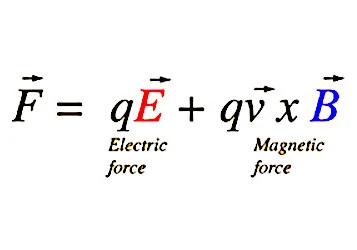
Description of the image: The Lorentz force is a fundamental force that acts on a charged particle moving in an electromagnetic field.
The Lorentz force, named after the Dutch physicist Hendrik Lorentz (1853-1928), is a fundamental force that acts on a charged particle moving in an electromagnetic field.
This force is essential to understand the behavior of charged particles in environments where electric and magnetic fields are present, such as in thunderstorms, transmission antennas, transformers, hard drives, MRIs, particle accelerators, magnetic levitation trains, etc.
The Lorentz force is considered a fundamental force because it is a direct manifestation of the electromagnetic interaction, which is one of the four fundamental forces of nature.
The Lorentz force describes the action of electric and magnetic fields on a charged particle: \( \vec{f} = q_e \vec{e} + q_b \vec{v} \times \vec{B} \)
The term qE represents the force exerted on the particle by the electric field. This component of the Lorentz force is independent of the particle's velocity and acts in the direction of the electric field. The force is proportional to the particle's charge and the intensity of the electric field.
The term qv × B represents the force exerted on the particle by the magnetic field. This force depends on the particle's velocity and is perpendicular to both the direction of the particle's velocity and the direction of the magnetic field. It is proportional to the particle's charge, the particle's velocity, and the intensity of the magnetic field.
The magnetic force does no work on the particle because it is always perpendicular to the direction of motion. As a result, it only changes the direction of the particle's velocity without altering its kinetic energy.
The Lorentz force is a manifestation of the electromagnetic interaction, which is one of the four fundamental forces of nature. It is essential to understand the behavior of charged particles in the presence of electric and magnetic fields and plays a crucial role in many physical phenomena and technological applications. Its fundamental nature is rooted in its direct derivation from the principles of electromagnetism and its unified description within the framework of special relativity and quantum electrodynamics.
The Lorentz force is universal and applies to all charged particles, whether they are electrons, protons, ions, etc.